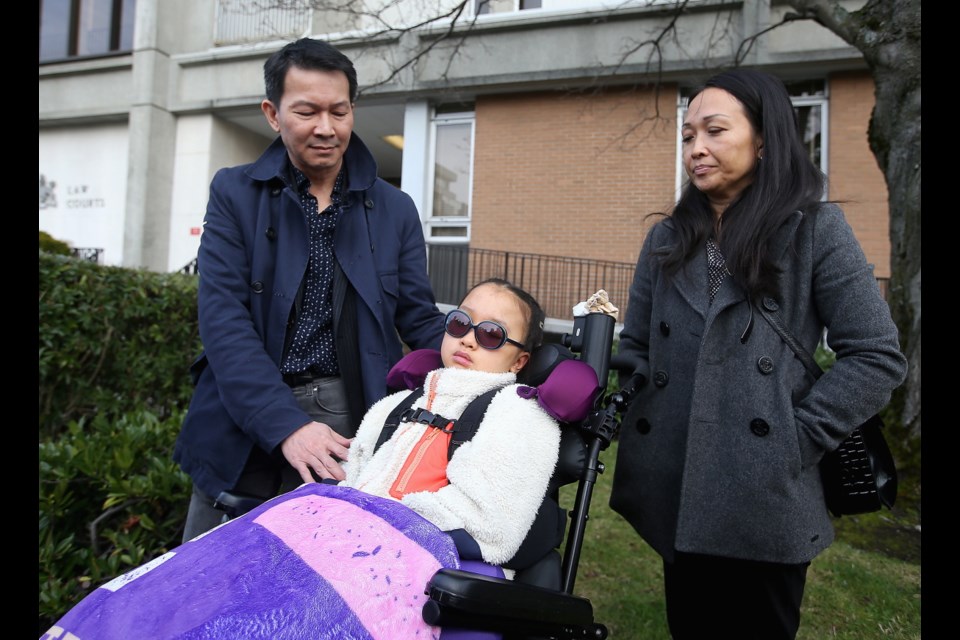The Victoria woman who struck and catastrophically injured 11-year-old Leila Bui in a crosswalk two years ago has been convicted of dangerous driving causing bodily harm.
On Monday, provincial court Judge Mayland McKimm found Tenessa Nikirk was speeding, texting and not paying attention to the girl, crosswalk markings at Ash Road and Torquay Drive and other drivers who had already stopped at the intersection about 8:15 a.m. on Dec. 20, 2017.
“Because of that, she failed to see that which is plainly there to be seen,” said McKimm, who found Nikirk’s driving both before the accident and at the time of the accident was dangerous to other users of the road.
Leila was thrown 26 metres before coming to a stop, wedged under an oncoming car. She suffered severe brain damage, a fractured neck and a lacerated spleen.
Leila’s parents, Kairry and Tuan, brought their injured daughter, now 13, in her wheelchair to court on Monday.
“We wanted her to hear what the judge’s decision was,” said Tuan. “We want people to know that this is what happened and she had a lot of goals and ambitions in her life and this was taken away from her, robbed from her. We just want her to know we’re here for her and we’re always going to be there to help her through this whole process. And this is just another step forward. We’re glad it’s over, but we have lots of work ahead of us. And we’re going to try to move forward and just focus on getting her well.”
Nikirk, who was behind the wheel of a black Mercedes SUV, came to the attention of other drivers more than five kilometres before the collision, said the judge. During the trial, one driver testified that Nikirk’s vehicle was following her so closely, she could only see the grille on her car.
The tailgating took place while Nikirk was also texting. Between 8 a.m. and 8:24 a.m., she sent 12 texts and received 13 texts, McKimm noted.
“She was distracted,” said McKimm.
He accepted evidence from a witness that Nikirk was constantly looking up and down into her lap at the stop light at Royal Oak Drive and Cordova Bay Road.
“Her attempt to secret this behaviour by keeping the phone in her lap confirms her own knowledge that this behaviour was illegal.”
Nikirk was also speeding excessively, McKimm found. The route she drove that morning has a posted speed limit of 50 kilometres per hour. Dash-cam video captured her passing two vehicles at once, at a speed estimated by experts to be 95 to 100 kilometres per hour.
A video analyst also found that 500 metres later, Nikirk was travelling 80 kilometres an hour when she was passed on the other side of the road by a B.C. Transit bus.
Many witnesses testified about the scene of the accident and all of their evidence paints a similar, clear and convincing picture of the scene, said McKimm.
Leila left home around 8:10 a.m. to walk to school. She was a few metres from home when she stopped at the crosswalk. Three drivers saw her looking right and left.
Nikirk was travelling east on Ash Road. A driver travelling west saw Leila and stopped his car. Shaun Steele, who was driving north on Torquay, saw Nikirk’s vehicle speeding up Ash Road and became very concerned because she wasn’t slowing down. Steele sounded his horn to warn Nikirk. At the same time, Bui ran across the crosswalk and was hit by Nikirk’s vehicle.
Nikirk got out of the Mercedes. Witnesses commented that she was playing music loudly.
Nirkirk did not testify. Her defence lawyer, Tom Morino, argued that the accident was inevitable and Leila was not visible.
Crown prosecutor Jess Patterson argued that the collision was the result of a continuing pattern of dangerous driving.
McKimm agreed, finding that the tailgating, texting, high-speed passing and high-speed driving was followed by a “complete failure to observe the warning signs as she approached the crosswalk.”
An accident reconstructionist said Nikirk was travelling between 53 and 67 kilometres per hour when she struck Leila.
“I do find that she was travelling well in excess of the speed limit at the time of the impact,” said McKimm.
The two stopped vehicles at the crosswalk would have signalled to a reasonable driver that something was happening at the crosswalk that required a driver to stop, not to proceed in excess of the speed limit, said McKimm.
“I am satisfied that the child standing at the crosswalk ready to cross from south to north was clearly visible to the accused had she been paying attention,” said the judge.
Although McKimm said he could not be sure Nikirk was texting at the moment of impact, he found she was distracted.
“At a minimum, her thoughts were elsewhere,” he said.
McKimm, who drove the route Nikirk took that morning, found that despite the steep hill on Ash Road, there is an abundance of time to observe the crosswalk markings and the yellow flashing light and to prepare to enter the intersection.
“I am satisfied that a reasonably prudent driver in these circumstances would be aware of the risks posed by her pattern of driving and taken steps to avoid those risks.”
Throughout the judge’s comments, Nikirk sat wiping away tears.
A date for her sentencing will be scheduled on Feb. 4.
ldickson@timescolonist.com



